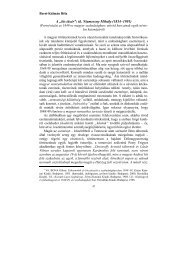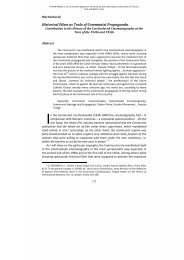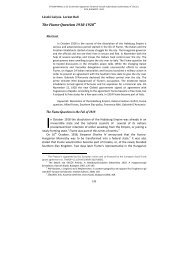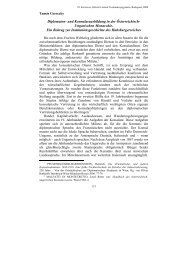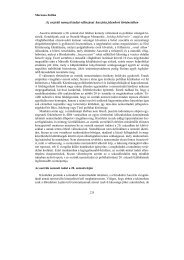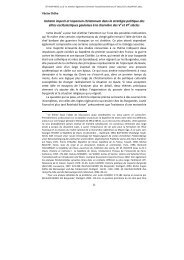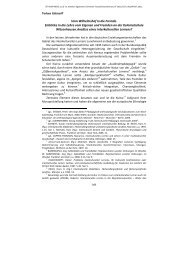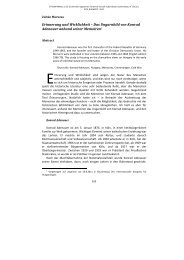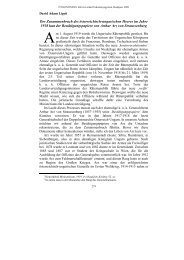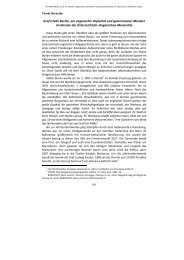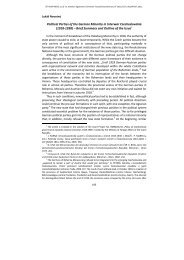The Molotov-Ribbentrop Pact - ELTE BTK Történelem Szakos Portál
The Molotov-Ribbentrop Pact - ELTE BTK Történelem Szakos Portál
The Molotov-Ribbentrop Pact - ELTE BTK Történelem Szakos Portál
You also want an ePaper? Increase the reach of your titles
YUMPU automatically turns print PDFs into web optimized ePapers that Google loves.
In summary, the group of the „Moderates” outnumbered the radicals,<br />
occupied most of the authorities, and according to their self-conception they<br />
protected the Slovak nation from any foreign influence. <strong>The</strong>y wanted to keep<br />
the ideology of the Slovak national movement pure, and referred faithfully to<br />
the paradigms mentioned above. <strong>The</strong>y wanted to avoid the smell of imitation.<br />
In their understanding only the party itself had the capacity to create, form,<br />
develop and implement the Slovak nationalism. <strong>The</strong>y wanted to create a selfstanding<br />
typology for the young state without using any pre-set position,<br />
without using the basis of an other prototyp. This self-concept seems illusory,<br />
but the reactionary policy of the HSPP was either singular, nor exceptional<br />
during this age in Europe. <strong>The</strong> ideas were widespread throughout the continent<br />
and carried on an unfortunate tradition.<br />
<strong>The</strong> common enemy<br />
Slovaks, Hungarians and Germans lived in the Slovak Republic, but all<br />
political power was bundled in the hands of the HSPP. For hiding this<br />
imbalance a common enemy had to be found. <strong>The</strong> community, the three ethnic<br />
groups, with their inherent inequality, needed a defining antipode. To transform<br />
the disparity groups into a community it needed a defining „other”. When the<br />
three groups spot an outsider, suddenly the groups were related and bound<br />
together.<br />
<strong>The</strong> Jews were stigmatized as the connecting enemy, as common hostile<br />
counterparts. <strong>The</strong> anti-Semitism did not have to be newly created or developed,<br />
it could refer to the catholic anti–Judaism, which was widespread throughout<br />
the country and deeply, devotedly believed by the governing party. <strong>The</strong><br />
HSPP´s anti-Semitism must not be seen as a product of technical consideration<br />
to deliver a common enemy for welding together the three groups. <strong>The</strong> HSPP<br />
preached the anti-Semitic resentment with creed.<br />
According to a population census in 1940 2,650,000 people lived in the<br />
Slovak Republic. 89,000 of them were Jews. 4<br />
<strong>The</strong> anti-Semitism bound the three ethnic groups together and even<br />
moulded the belligerent opponents within the HSPP into a close unity. <strong>The</strong><br />
internal split was none existent when it came to the anti-Jewish policy of<br />
the government. Although originally the anti-Semitism of the „Moderates”<br />
was grounded in the catholic anti-Judaism, and the anti-Semitism of the<br />
„Radicals” was leaned on a racial doctrine, the following steps were<br />
supported fully by both groups. Disagreement existed only when the<br />
question arose of how to treat converts. <strong>The</strong> „Moderates” refused the<br />
deportation of 4,000 converts, but for the „Radicals” being Jewish was not a<br />
religious question – it was a question of descent. <strong>The</strong>ir understanding<br />
4 HILBERG, Raul: <strong>The</strong> destruction of the european jews. Harper & Row, New York, 1979. 434.<br />
64



